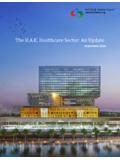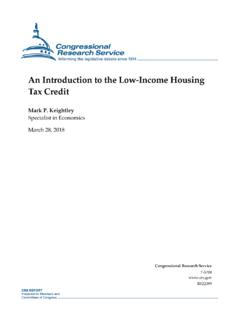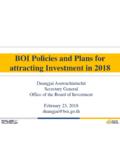Transcription of Renewable and Alternative Energy in the U.A.E.
1 Renewable and Alternative Energy in the Overview and Opportunities for Business January 2017 introduction Over the past decade, the has demonstrated a serious commitment to the development of Renewable and Alternative Energy . The is currently installing four major nuclear power plants in the emirate of Abu Dhabi. It is also playing a leading role in solar, wind, and other Renewable Energy projects both in the and abroad. These initiatives should not be dismissed as mere attempts to bolster the s public image and international standing. Rather, they are strategic choices by the s leadership to promote the economic well being of the country and its people. After all, these programs: Help meet the s growing demand for power. The s Energy demand is increasing at an annual rate of about 9%, due largely to population growth and expanding industrial Reduce the s dependence on natural gas imports. The is currently a net importer of natural gas, with gas imports from Qatar via the Dolphin Pipeline meeting approximately 30% of the s Energy Preserve the s lucrative oil exports.
2 Petroleum exports generated almost $53 billion in Protect the s environment and thus promote the health and wellbeing of its citizens. Provide business opportunities for companies and thereby create employment possibilities for nationals. This last point is particularly important. Since its independence, the has made great strides in diversifying its economy away from oil, emerging as a regional hub for trade, travel, tourism, finance, healthcare, and education. As a result, in October 2015, Minister of Economy His Excellency Sultan bin Saeed Al Mansouri noted that the s non-oil sector contributed to 70% of the country s The development of Renewable and Alternative Energy is one of the next pillars of the s economic diversification strategy. As such, it will help the country realize the vision of His Highness Sheikh Mohammed bin Zayed Al Nahyan, Crown Prince of Abu Dhabi and Deputy Supreme Commander of the Armed forces, to have the celebrate the export of its last barrel of This report begins by reviewing the leadership s stated commitments to meeting certain Renewable and Alternative Energy targets.
3 It then provides an overview of key Renewable and Alternative Energy institutions, projects, 1 investments, research, and events associated with the Finally, it concludes by highlighting opportunities and resources for businesses interested in this sector. Throughout, this report references the long history of successful partnerships that have helped make the a regional leader in the Renewable and Alternative Energy fields. 2 Table of Contents introduction .. 0 THE S Renewable AND Alternative Energy COMMITMENTS .. 3 Renewable AND Alternative Energy INSTITUTIONS IN THE .. 4 Renewable AND Alternative Energy PROJECTS IN THE .. 5 A. Nuclear .. 5 B. Solar .. 6 C. Other .. 8 Renewable Energy PROJECTS AND INVESTMENTS ABROAD .. 9 A. 9 B. Wind .. 10 Renewable AND Alternative Energy RESEARCH IN THE .. 10 A. 10 B. Biofuels .. 11 C. Other .. 11 Renewable AND Alternative Energy EVENTS IN THE .. 11 BUSINESS OPPORTUNITIES.
4 12 RESOURCES .. 13 A. Government Institutions .. 13 B. Government Institutions .. 14 C. Trade Associations .. 16 REFERENCES .. 18 3 THE S Renewable AND Alternative Energy COMMITMENTS The has not only committed to implementing global climate change agreements, but it has also formulated ambitious plans for the introduction of Renewable and Alternative Energy at a national and Emirate level. In September 2016, the ratified the Paris Agreement on climate change. Under this agreement, 196 nations resolved to limit global warming to a maximum of 2 degrees Celsius. In ratifying this agreement when it did, the became the first country in the Middle East to do so, demonstrating its leadership role on this important The s signing of the Paris Agreement followed its creation of a Ministry of Climate Change and the Environment. In February 2016, the restructured its government departments so as to increase efficiency and better reflect its strategic objectives.
5 Its decision to rename the Ministry of Environment and Water as the Ministry of Climate Change and Environment demonstrated its commitment to a green economy and This commitment is also apparent in the country s national vision Vision 2021. One of the six pillars of this vision is creating a Sustainable environment and infrastructure. Moreover, one of the key performance indicators for this pillar is increasing the contribution of clean Energy to the s total Energy mix from in 2015 to 27% by The s dedication to Renewable and Alternative Energy is also encapsulated in its National Strategy for Innovation. This strategy identifies seven key innovation sectors, one of which is Renewable Building on this strategy, in November 2015, President His Highness Sheikh Khalifa bin Zayed Al Nahyan announced a 300 billion AED [$ billion] Emirates Science, Technology and Innovation Higher Policy fund, 200 billion AED [$ billion] of which was earmarked for Renewable and Alternative At the same time the federal government has laid out the country s vision for a green Energy future, Dubai has presented a complimentary emirate-level vision the Dubai Clean Energy Strategy 2050.
6 This strategy, unveiled in November 2015 by Prime Minister and Ruler of Dubai His Highness Sheikh Mohammed bin Rashid Al Maktoum, calls for clean Energy to account for 7% of Dubai s Energy needs by 2020, 25% of its needs by 2030, and 75% by 2050. In order to meet these targets, the strategy entails the creation of both a new clean Energy free zone called the Dubai Green Zone and a 100 billion AED [$ billion] clean Energy fund called the Dubai Green Fund. In addition, the strategy involves a 50 billion AED [$ billion] expansion of Dubai s Mohammed bin Rashid Al 4 Maktoum Solar Park as well as the installation of rooftop solar panels throughout the Emirate by Renewable AND Alternative Energy INSTITUTIONS IN THE In line with its commitment to Renewable and Alternative Energy , the has become home to several world-class institutions in this field, such as IRENA and Masdar. Since 2009, the has hosted the global headquarters of the International Renewable Energy Agency (IRENA).
7 IRENA is an intergovernmental organization that supports countries in their transition to a sustainable Energy future by serving as a platform for international cooperation, a center of excellence, and a repository of policy, technology, resources, and financial knowledge. xii In 2009, Abu Dhabi was designated as the interim seat of IRENA. Two years later, the capital became IRENA s permanent home, making IRENA the first intergovernmental organization to be headquartered in the Middle East region. IRENA officially inaugurated its 32,000 square-meter permanent headquarters in In addition to hosting the world s leading international Renewable Energy body, the is home to Masdar. Masdar, which was established by the Mubadala Development Company in 2006 as the country s future Energy company, built a sustainable urban development and economic freezone in Abu Dhabi called Masdar City with the help of companies such as CH2M Hill and From this city, which serves as a greenprint for cities of the future, Masdar has advanced the development, commercialization, and deployment of Renewable Energy and clean technologies through businesses focusing on clean Energy deployment and sustainable real estate.
8 The nucleus of Masdar City is the Masdar Institute of Science and Technology an independent, research-driven graduate university that works closely with the Massachusetts Institute of Technology (MIT).xv1 Masdar City also has an incubator building, which is the site of exciting projects such as Lockheed Martin s Center for Innovation and Security Solutions and General Electric s Ecomagination Masdar and IRENA are not the only institutions working to develop Renewable Energy in the Ras Al Khaimah hosts a graduate-level campus of the cole 1 In October 2016, the Abu Dhabi Executive Council approved the merger of three of the capital s most prestigious universities: Khalifa University, Masdar Institute, and the Petroleum Institute. It is unclear when the merger will take effect. Masdar City 5 Polytechnique F d rale de Lausanne that is focused on Energy and Moreover, in November 2015, His Highness Sheikh Mohammed bin Rashid Al Maktoum inaugurated construction works on the DEWA Energy Centre, which includes a group of research and development laboratories under its umbrella with a total investment of 500 million AED [$136 million].
9 Xviii Renewable AND Alternative Energy PROJECTS IN THE With the support of these institutions, the has begun transforming its Energy mix through Renewable and Alternative Energy projects, particularly with respect to nuclear and solar Energy . A. Nuclear The s most ambitious Alternative Energy project is in the field of nuclear Energy . The s nuclear Energy program first took shape in 2009 with the creation of two key government bodies: The Federal Authority for Nuclear Regulation (FANR), which regulates all nuclear The Emirates Nuclear Energy Corporation (ENEC), which oversees the design, construction, and operation of nuclear power plants; ensures the s nuclear power program is coordinated with that country s industrial infrastructure plans; builds the human resource capacity among Emiratis for a successful nuclear program; and informs the public about this After its creation, ENEC awarded two important contracts.
10 First, it tasked CH2M Hill with helping manage the nuclear Then, it charged a consortium led by Korea Electric Power Corporation (KEPCO) to build four 1400 MW reactors in Abu Dhabi s Western region: Barakah 1, Barakah 2, Barakah 3, and Barakah The KEPCO-led consortium s construction of these four reactors is reportedly proceeding on schedule. Starting in 2017, one of these reactors is due to come online every year for four years. When completed in 2020, these four reactors will provide for one-quarter of the s total electricity Once these reactors are complete, they will be operated and maintained by the Nawah Energy Company, a recently-created ENEC subsidiary that is 18% owned by The plants are expected to be operational for around 60 6 While KEPCO is leading the consortium building these reactors, companies have been critical in their construction. In June 2016, ENEC said that over 11 billion AED [$3 billion] in contracts had been awarded to approximately 1,400 local companies.












